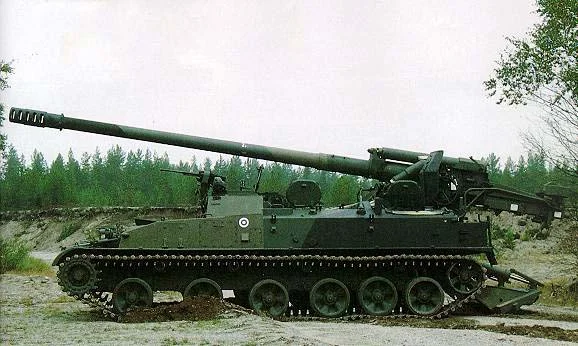- Extended Description
- 2S5 Giatsint-S 152-mm Self-Propelled Gun
The 152-mm self-propelled gun 2S5 (previously known as M1981) is an unturreted gun mounted on a six-roadwheeled tracked chassis similar to that of the 152-mm self-propelled howitzer 2S3. The nuclear-capable 2S5, along with its towed counterpart M1976, replaced the 130-mm field gun M-46 in gun battalions organic to artillery regiments and brigades at front and army level. It was fielded in 1981 and was deployed with Soviet forces in Eastern Europe during 1982. This deployment was part of an upgrade of Soviet nuclear and conventional theater forces and indicates the importance Soviet doctrine places on the capability to deliver low-yield nuclear strikes relatively close to Soviet forces.
The 2S5 152-mm Self-Propelled Gun is more powerful, has a longer range and a higher rate of fire than the 2S3. However, the 2S5 has a limited main armament traverse and a narrower elevation range than the 2S3.
The all-welded steel armor chassis of the 2S5 has a maximum thickness of about 15-mm, providing the crew with some protection from small arms fire and shell splinters. A front-mounted dozer blade is used for clearing obstacles and preparing firing positions, in accordance with standard Russian doctrine, without the need for specialized engineer support [in constrast, American doctrine stresses mobility for survivability]. A large rear-mounted spade dig into the ground providing a more stable platform when the deployed in the firing position. A 7.62-mm machine gun mounted on the forward part of the cupola can be operated remotely, and a white light searchlight being mounted on the left side. The commander is provided with periscopes and other viewing devices. Standard equipment for the 2S5 includes an NBC system and infra-red night equipment for the driver and commander.
The long barrel of the 152-mm main gun is mounted externally to the rear, and is held in position by a travel lock when traveling. It is fitted with a five part multi-baffle muzzle brake. Crew fatigue is reduced by a semi-automatic loading system consisting of an electrically driven chain rammer left of the breech, a projectile tray and a charge tray. The projectile and charge are loaded in the trays and then swung upwards through almost 90 where the rammer rams the projectile then the charge. When not in operation the loading system folds back 90 parallel to the breech and the projectile and charge-loading system, which pivots on the right side.
The 2S5 takes three minutes to set up for action and about as long to secure for movement. A unit of fire is 60 rounds, and the mechanical ammunition-handling system enables a maximum rate of fire of 5-6 rounds/minute to be achieved. Ammunition is of the separate projectile and charge type, which can be supplied from on board via the rear of the vehicle or from the ground. A total of 30 rounds is carried, with projectiles stowed vertically in a carousel on the left of the rear compartment. The 30 propellant charges on the right in three rows of 10, stowed vertically on a horizontal conveyor belt that runs under the floor of the vehicle. The propellant charge consists of a cartridge case, and after firing the breech automatically opens and ejects the spent cartridge case.
The maximum range firing conventional ammunition is 28500-meters, while a range of 40,000-meters can be achieved using a rocket-assisted projectile. The standard high explosive fragmentation projectile weighs 46 kg, with propellant and cartridge weighing up to 34 kg. Other types of ammunition include chemical, concrete-piercing, improved conventional munitions and tactical nuclear.











